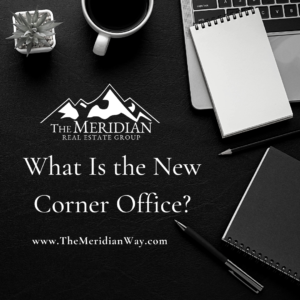 Changing our offices means changing the ways that we perceive success in an organization. Having an office, a permanent place to put your things or be alone, is a universal signal of value. It is an acknowledgment of commitment from employer to employee. It tells them that they belong, that they deserve a place. We even have a hierarchy for offices, particularly when it comes to the kind of people that are allowed to use them. The pinnacle of which is the corner office. “Corner office” has even become slang of its own, akin to “C-Suite” and “Higher-Ups.”
Changing our offices means changing the ways that we perceive success in an organization. Having an office, a permanent place to put your things or be alone, is a universal signal of value. It is an acknowledgment of commitment from employer to employee. It tells them that they belong, that they deserve a place. We even have a hierarchy for offices, particularly when it comes to the kind of people that are allowed to use them. The pinnacle of which is the corner office. “Corner office” has even become slang of its own, akin to “C-Suite” and “Higher-Ups.”
If we want to take that affirmation away from people, if we have to get rid of corner offices, we need to find out what else it can be replaced with. We have to think about what not aspiring to be the one in the office means for the way that achievement and belonging are perceived in the organization. That means that the first step in the path toward rethinking a workplace starts with introspection. “Before you decide what your office will be you first have to understand the corporate culture,” said Mahesh Vidyasagar, Head of Real Estate at Robert Half, a staffing and recruiting firm.
Vidyasagar has spent his career in real estate and he accepts the emotional connection people have with it. “Real estate is personal, if you mess with it there are always tensions,” he told me. When he was brought in to help Robert Hall rethink their office footprint he started by first understanding the organization. Soon he came to realize that they had the type of flat hierarchy and open culture that would lend itself well to flexible work. Then he started to ask what the employees thought about having a flexible office and, of course, losing the corner offices.
“What I learned was that for many, flexibility is the new corner office,” he said. Now he believes what makes people feel valued and trusted is allowing them to choose their own schedules. Losing a personal office isn’t so impactful when it allows people to use an office when and how they want. Allowing for flexible work arrangements shows a type of trust that is hard to replicate, even with a dedicated office.
What works for some organizations might not work for others. The personal impacts of a change to a workplace vary greatly from person to person and team to team. But, using a bit of empathy to understand people’s jobs goes a long way, according to Vidyasagar. As head of Corporate Real Estate for Comcast’s West Division, he was faced with the hard decision of whether or not to invest in standing desks in their call centers. “They were so expensive at the time and we didn’t know if it was worth it,” he said.
After spending time in a call center, seeing what they did every day, and talking to them about their job he realized that the work was very hard and often seen as unhealthy both mentally and physically. So, his team decided to make the investment in the standing desk, despite the costs. “We instantly saw benefits, both in morale and in productivity,” Vidyasagar said. Besides the obvious health benefits of not being forced to sit all day at a desk, employees appreciated the thought that went into the investment as well, “they just liked knowing that we cared about them enough to invest in them.”
The connection between employee happiness and productivity is well studied in academia. But as much as many office and facilities managers would like to use employee morale and employee output as metrics for office success, the subjective nature of both of the concepts makes it nearly impossible. The metric for success that Vidyasagar likes to use instead was a bit surprising to me, both for its freshness and its simplicity. He boiled down the office’s impact on an organization into market share per square foot. He thinks that only by comparing an office footprint to the overall strength of a company can you really understand the intrinsic value of an effective workplace.
Rather than merely thinking about office density or trying to peg it to something as subjective as productivity, Vidyasagar thinks that the office should be seen for its entire benefit to the company. Sometimes those benefits, like morale, creativity, and culture are hard to fully measure. But what can be easily understood is how the company is performing against its competitors. If the organization is able to increase its market share without the need for more office space, that equals an improvement.
When employees are no longer tied to the office, their work shouldn’t be either. As organizations look to overhaul their workplaces they also need to answer an important question, “In the modern office, how can we give employees what makes them feel valued?” Only by learning this can they really create a space that helps boost an organization. Companies that ask that question might be surprised by what they find. Priorities have shifted and based on the new way that people are thinking about their work life, it might be that flexibility is actually the new corner offices.
Thank you to Propmodo for this article. To read more, click here!